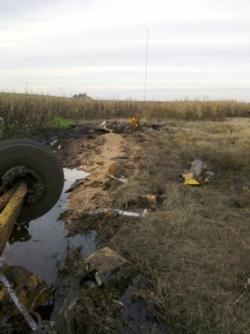Fri, May 24, 2013
Move The Result Of Three Accidents Involving Airplanes Colliding With Meteorological Evaluation Towers
The NTSB has issued six broad-reaching safety recommendations after three accidents in which airplanes collided with Meteorological Evaluation Towers (METs). In each of the accidents, which occurred between 2005 and 2011, the MET was unmarked and unlighted. All resulted in fatal injuries. In the 2011 case, the permit for the MET had expired more than a year before the accident occurred, but it had not been removed as stipulated by its permit. The Board says that METs are often temporary structures, and at under 200 feet tall, are not required to be marked and lighted by the FAA.

The Board recommends that the FAA amend 14 Code of Federal Regulations Part 77 to require that all meteorological evaluation towers be registered, marked, and—where feasible—lighted, and that the agency create and maintain a publicly accessible national database for the required registration of all meteorological evaluation towers.
They further recommend that the American Wind Energy Association revise the Wind Energy Siting Handbook to clearly indicate the hazards that meteorological evaluation towers (MET) pose to low-altitude aviation operations and encourage voluntarily marking them to increase their visibility by reference to Advisory Circular70/7460-1, “Obstruction Marking and Lighting.” The association should also inform members about the circumstances of the airplane accidents that have occurred in connection with the presence of meteorological evaluation towers (MET) and emphasize the importance of understanding the aviation safety hazards associated with METs when erecting them.
The Board says that in the review and approval of applications processes for the construction of METs conducted by the United States Department of the Interior, the United States Department of Defense, and the United States Department of Agriculture, applicants should be provided a copy of, or directed to Advisory Circular 70/7460-1, “Obstruction Marking and Lighting.”
Finally, the board urged 46 States, the District of Columbia, the commonwealths of Puerto Rico and the Northern Mariana Islands, and the territories of America Samoa and the U.S. Virgin Islands to pass legislation requiring that meteorological evaluation towers be marked and registered in a directory.
(NTSB image of accident site with MET visible in the background)
More News
With Testing Soon Complete, Launch Preparations Begin in Earnest Sierra Space's Dream Chaser has been put through the wringer at NASA's Glenn Armstrong Test Facility in Ohio, but w>[...]
Takeoff Roll The process whereby an aircraft is aligned with the runway centerline and the aircraft is moving with the intent to take off. For helicopters, this pertains to the act>[...]
“We’re proud of the hard work that went into receiving this validation, and it will be a welcome relief to our customers in the European Union. We couldn’t be mor>[...]
"Aircraft Spruce is pleased to announce the acquisition of the parts distribution operations of Wag-Aero. Wag-Aero was founded in the 1960’s by Dick and Bobbie Wagner in the >[...]
IDENT Feature The special feature in the Air Traffic Control Radar Beacon System (ATCRBS) equipment. It is used to immediately distinguish one displayed beacon target from other be>[...]
 Sierra Space Repositions Dream Chaser for First Mission
Sierra Space Repositions Dream Chaser for First Mission ANN's Daily Aero-Term (05.10.24): Takeoff Roll
ANN's Daily Aero-Term (05.10.24): Takeoff Roll Aero-News: Quote of the Day (05.10.24)
Aero-News: Quote of the Day (05.10.24) Aero-News: Quote of the Day (05.11.24)
Aero-News: Quote of the Day (05.11.24) ANN's Daily Aero-Term (05.11.24): IDENT Feature
ANN's Daily Aero-Term (05.11.24): IDENT Feature



